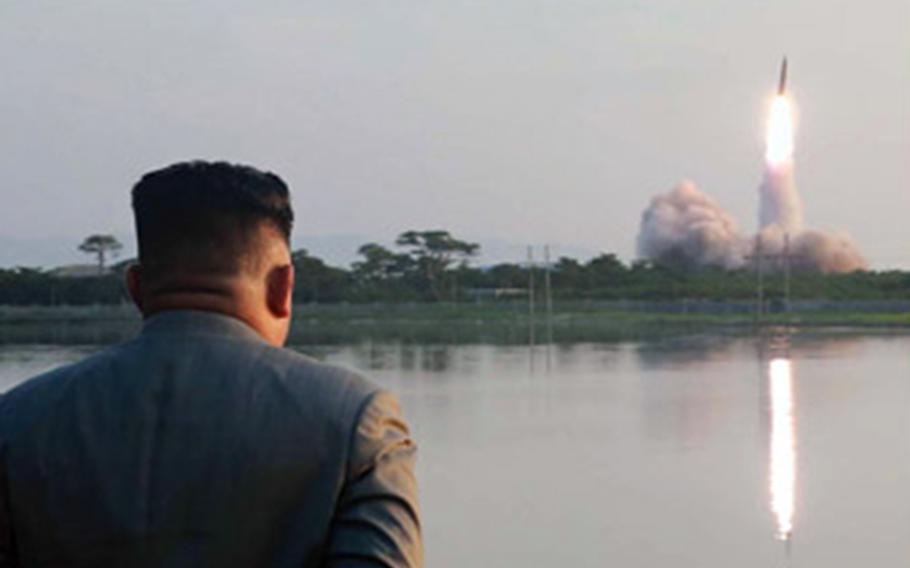
North Korean leader Kim Jong Un watches a missile launch in this undated photo released by the Korean Central News Agency, Friday, July 26, 2019. (KCNA)
SEOUL, South Korea — North Korea said Friday that its latest missile test was a “solemn warning” to South Korea against joint military exercises with the United States, while Secretary of State Mike Pompeo suggested the launch would not disrupt the resumption of nuclear talks.
The North fired two short-range missiles into the sea off its eastern coast on Thursday, the first launch since President Donald Trump met with North Korean leader Kim Jong Un at the Korean border on June 30 and agreed to resume stalled nuclear talks.
Playing down the launch, Pompeo said he anticipated negotiations would start “in a couple weeks.”
“Look, everybody tries to get ready for negotiations and create leverage, and create risk for the other side,” he said Thursday in an interview with Bloomberg TV. “President Trump has been incredibly consistent here. We want diplomacy to work.”
The comments came before the North released photos of the missiles launched and issuing the warning against military exercises. New details also emerged about the weapons fired.
‘Not a threat’The Combined Forces Command, which is led by the top U.S. general in South Korea, said the launches appeared to be “a test of a new type of missile,” reinforcing the South Korean assessment.
“These two short-range ballistic missiles were not a threat directed at [South Korea] or the U.S. and have no impact on our defense posture,” the command said Friday in a statement.
South Korea’s military, meanwhile, said both missiles flew more than 370 miles, revising its earlier estimate. They reached an altitude of about 32 miles, officials said.
The new missiles appeared to be similar to Russia’s Iskander model, according to a spokesman for South Korea’s Joint Chiefs of Staff, Col. Kim Joon-rak.
That means they could be designed to avoid American and South Korean defenses on the divided peninsula, including the U.S. Terminal High Altitude Area Defense system known as THAAD.
The North also fired two short-range missiles in early May, and the Korean leader was shown inspecting a new submarine in photos released Wednesday.
The North warned earlier this month that it may restart testing in its nuclear weapons program to protest joint U.S.-South Korean drills expected to take place next month. ‘Solemn warning’
Kim oversaw the demonstration of a “new-type tactical guided weapon,” the state-run Korean Central News Agency reported.
KCNA said the demonstration was aimed at sending “a solemn warning to the South Korean military warmongers who are running high fever in their moves to introduce the ultramodern offensive weapons and hold military exercises in defiance of the repeated warnings” from the North.
North Korea hates the joint exercises, which it considers rehearsals for an invasion.
Trump said he was “stopping the war games” after his first summit with Kim in June 2018 as diplomatic efforts to persuade the North to abandon its nuclear weapons gained momentum.
The U.S. and South Korea reorganized the training programs, canceling the major drills that occurred in the autumn and the spring but holding lower-profile computer simulated exercises that involved fewer people.
North Korea has continued to object to the drills despite the name changes and smaller size.
Officials said earlier this month that the allies are preparing to hold the next one later this year as planned, although no date has been set.
The North, which has been careful not to criticize Trump as the two leaders insist they maintain a good relationship, did not mention the United States in Friday’s report.
It also didn’t provide details about the weapons, although it said the system had “rapid anti-firepower capability” and flew at a low altitude “which would be hard to intercept.”
KCNA added that the weapons system “is of huge eventful significance in developing our armed forces and guaranteeing the security of the country by military force.”
It also criticized South Korea’s introduction of new weapons in an apparent reference to Seoul’s purchase of stealth F-35A fighter jets from the United States, which has begun delivery.
Kim called on President Moon Jae-in “to stop such suicidal acts as the introduction of ultra-modern weapons and military exercises and come back to the proper stand,” according to KCNA.
“The South Korean chief executive should not make a mistake of ignoring the warning from Pyongyang, however offending it may be,” it said.
‘Smaller ones’Trump expressed little concern in his first remarks about the launch.
“They haven’t done nuclear testing. They really haven’t tested missiles other than, you know, smaller ones, which is something that lots test,” he said in an interview with Fox News.
Kim has promised only to suspend nuclear and long-range missile tests, although all ballistic weapons activity is banned under U.N. Security Council resolutions.
Nuclear talks have remained deadlocked since a February summit between Trump and Kim in Vietnam ended without agreement as the two sides failed to agree on the extent of sanctions relief in connection with denuclearization.
The Trump administration insists its final goal is the fully verified denuclearization of North Korea but says it’s not in a hurry to make a deal.
“If we wait two weeks or four weeks or six weeks to make sure that we’ve had enough conversations so that there can be productive dialogue when the teams get together, that’s the real objective,” Pompeo told Bloomberg TV. “If it takes us another two weeks or four weeks, so be it.”
gamel.kim@stripes.com Twitter: @kimgamel